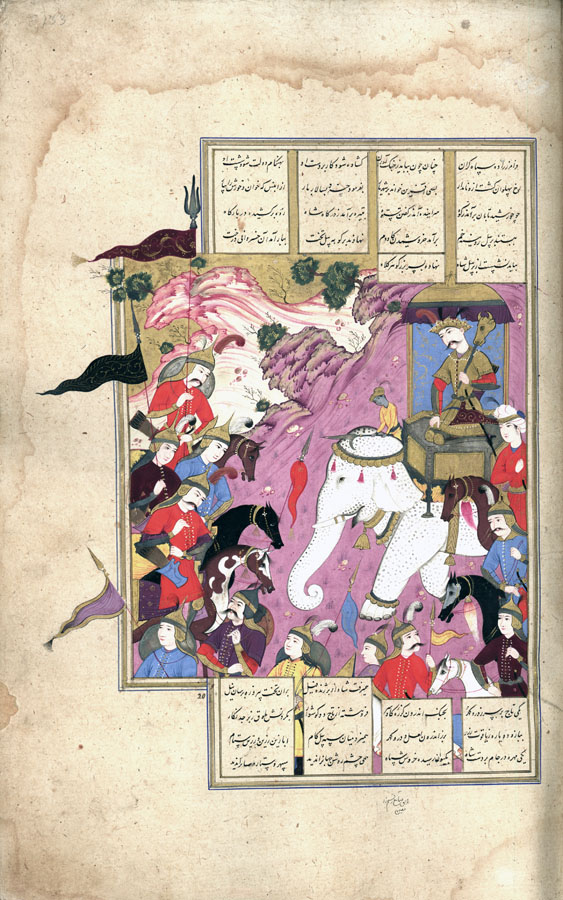Kay Ḵosrow Reviews His Troops
On the right side of the painting, Kay Ḵosrow is seated on a canopied throne that has been affixed to the back of a large white elephant, that advances toward the center of the picture. The canopied throne is the same one depicted on folio 130v. In accordance with the text, Kay Ḵosrow holds the bull-headed mace on his shoulder and wears a jewel encrusted crown, but there is no evidence of the jewelled collar or girdle. A diminutive dark-skinned driver, about one quarter the size of Ḵosrow, rides on the neck of the elephant. The elephant is adorned with a large bell hung around its neck, and rings of jangles on its head and feet. The shah’s troops, represented by eleven helmetted warriors and one turbanned attendant, form a semi-circle that runs down the right side, across the near foreground, and three quarters back up the left side. All appear to be mounted, but due to the spatial overlap and cropping of the figures in the foreground by the frame, only six of their mounts are visible. Five of the warriors carry standards. The setting is a barren sloping hillside that rises sharper than depicted in the other illustrations, and reaches a summit on the right side behind Ḵosrow’s head. There are two jagged outcroppings of rock on the left slope from which small bushes emerge, and beyond them in the far distance, is a second ridge line with even more fantastic outcroppings of coral-like rock.
There are four columns of text above and below the painting. At the top, two columns are comprised of five lines each, and the remaining columns of four lines each. Below the painting the columns are comprised of three or four lines respectively, but juxtaposed with the top columns, so that overall top and bottom each column has an equal number of total lines. A rectangular ruled frame encloses painting and text. The illustration is extended on the left side the width of an additional column, and the frame juts out to encompass it. In addition three standards, one on the top and two on the left, violate the frame and protrude into the margins.. The painting is signed in the lower margin, in miniscule characters in Moʿin’s hand: ze towfiq ṣānʿʿe raqam zad moʿin (drawn with the grace of the maker, by the most humble Moʿin). The inscription is not dated.
Painting references:
Welch, AK4_1978, p.90, Ms.22, folio 133r (not ill.), where the painting is identified as “Kai Khusrau and his army march into Turān”.
Text references:
Warner, III, pp.31-37; Mohl, II, pp.465-66; Levy, p.109.
Robert Eng
Last Updated: July 6, 2011 | Originally published: July 6, 2011
